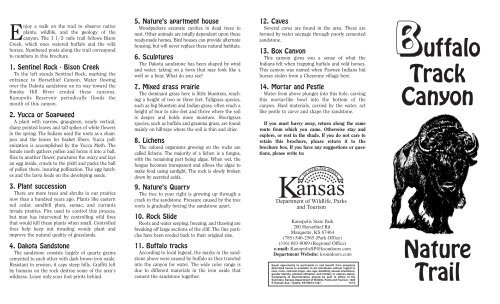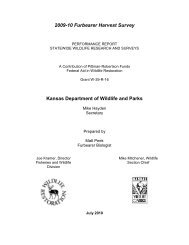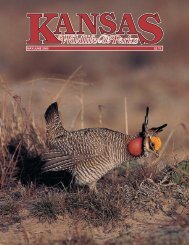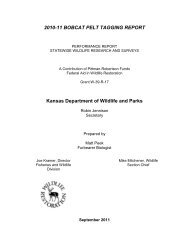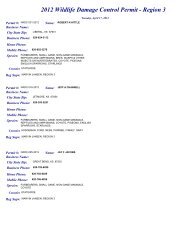Kanopolis SP Buffalo Track Canyon - Kansas Department of Wildlife ...
Kanopolis SP Buffalo Track Canyon - Kansas Department of Wildlife ...
Kanopolis SP Buffalo Track Canyon - Kansas Department of Wildlife ...
You also want an ePaper? Increase the reach of your titles
YUMPU automatically turns print PDFs into web optimized ePapers that Google loves.
Enjoy a walk on the trail to observe native<br />
plants, wildlife, and the geology <strong>of</strong> the<br />
canyon. The 1 1/2- mile trail follows Bison<br />
Creek, which once watered buffalo and the wild<br />
horses. Numbered posts along the trail correspond<br />
to numbers in this brochure.<br />
1. Sentinel Rock - Bison Creek<br />
To the left stands Sentinel Rock, marking the<br />
entrance to Horsethief <strong>Canyon</strong>. Water flowing<br />
over the Dakota sandstone on its way toward the<br />
Smoky Hill River eroded these canyons.<br />
<strong>Kanopolis</strong> Reservoir periodically floods the<br />
mouth <strong>of</strong> this canyon.<br />
2. Yucca or Soapweed<br />
A plant with narrow, gray-green, nearly vertical,<br />
sharp pointed leaves and tall spikes <strong>of</strong> white flowers<br />
in the spring. The Indians used the roots as a shampoo<br />
and the leaves for basket fibers. Yucca pollenization<br />
is accomplished by the Yucca Moth. The<br />
female moth gathers pollen and forms it into a ball,<br />
flies to another flower, punctures the ovary and lays<br />
an egg inside, crawls to the pistil and packs the ball<br />
<strong>of</strong> pollen there, insuring pollination. The egg hatches<br />
and the larva feeds on the developing seeds.<br />
3. Plant succession<br />
There are more trees and shrubs in our prairies<br />
now than a hundred years ago. Plants like eastern<br />
red cedar, sandhill plum, sumac, and currants<br />
invade prairies. Fire used to control this process,<br />
but man has intervened by controlling wild fires<br />
that would kill these plants when small. Controlled<br />
fires help keep out invading woody plant and<br />
improve the natural quality <strong>of</strong> grasslands.<br />
4. Dakota Sandstone<br />
The sandstone consists largely <strong>of</strong> quartz grains<br />
cemented to each other with dark brown iron oxide.<br />
Resistant to erosion, it caps steep hills. Graffiti left<br />
by humans on the rock destroy some <strong>of</strong> the area's<br />
wildness. Leave only your foot prints behind.<br />
5. Nature's apartment house<br />
Woodpeckers excavate cavities in dead trees to<br />
nest. Other animals are totally dependent upon these<br />
ready-made homes. Bird houses can provide alternate<br />
housing, but will never replace these natural habitats.<br />
6. Sculptures<br />
The Dakota sandstone has been shaped by wind<br />
and water, taking on a form that may look like a<br />
wolf or a bear. What do you see?<br />
7. Mixed grass prairie<br />
The dominant grass here is little bluestem, reaching<br />
a height <strong>of</strong> two or three feet. Tallgrass species,<br />
such as big bluestem and Indian grass, <strong>of</strong>ten reach a<br />
height <strong>of</strong> four to nine feet and thrive where the soil<br />
is deeper and holds more moisture. Shortgrass<br />
species, such as buffalo and gramma grass, are found<br />
mainly on hill-tops where the soil is thin and drier.<br />
8. Lichens<br />
The colored organisms growing on the rocks are<br />
called lichens. The majority <strong>of</strong> a lichen is a fungus,<br />
with the remaining part being algae. When wet, the<br />
fungus becomes transparent and allows the algae to<br />
make food using sunlight. The rock is slowly broken<br />
down by secreted acids.<br />
9. Nature's Quarry<br />
The tree to your right is growing up through a<br />
crack in the sandstone. Pressure caused by the tree<br />
roots is gradually forcing the sandstone apart.<br />
10. Rock Slide<br />
Roots and water seeping, freezing, and thawing are<br />
breaking <strong>of</strong>f large sections <strong>of</strong> the cliff. The fine particles<br />
have been eroded back to their original size.<br />
11. <strong>Buffalo</strong> tracks<br />
According to local legend, the marks in the sandstone<br />
above were caused by buffalo as they traveled<br />
into the canyon for water. The wide color range is<br />
due to different materials in the iron oxide that<br />
cement the sandstone together.<br />
12. Caves<br />
Several caves are found in the area. These are<br />
formed by water seepage through poorly cemented<br />
sandstone.<br />
13. Box <strong>Canyon</strong><br />
This canyon gives you a sense <strong>of</strong> what the<br />
Indians felt when trapping buffalo and wild horses.<br />
This canyon was named when Pawnee Indians hid<br />
horses stolen from a Cheyenne village here.<br />
14. Mortar and Pestle<br />
Water from above plunges into this hole, carving<br />
this mortar-like bowl into the bottom <strong>of</strong> the<br />
canyon. Hard materials, carried by the water, act<br />
like pestle to carve and shape the sandstone.<br />
If you must hurry away, return along the same<br />
route from which you came. Otherwise stay and<br />
explore, or rest in the shade. If you do not care to<br />
retain this brochure, please return it to the<br />
brochure box. If you have any suggestions or questions,<br />
please write to:<br />
<strong>Kanopolis</strong> State Park<br />
200 Horsethief Rd.<br />
Marquette, KS 67464<br />
(785) 546-2565 (Park Office)<br />
(316) 683-8069 (Regional Office)<br />
e-mail: <strong>Kanopolis</strong><strong>SP</strong>@ksoudoors.com<br />
<strong>Department</strong> Website: ksoutdoors.com<br />
Equal opportunity to participate in and benefit from programs<br />
described herein is available to all individuals without regard to<br />
race, color, national origin, sex, age, disability, sexual orientation,<br />
gender identity, political affiliation, and military or veteran status.<br />
Complaints <strong>of</strong> discrimination should be sent to Office <strong>of</strong> the<br />
Secretary, <strong>Kansas</strong> <strong>Department</strong> <strong>of</strong> <strong>Wildlife</strong>, Parks and Tourism, 1020<br />
S <strong>Kansas</strong> Ave., Topeka, KS 66612-1327. 11/12<br />
<strong>Buffalo</strong><br />
<strong>Track</strong><br />
<strong>Canyon</strong><br />
Nature<br />
Trail
POND<br />
Prairie Trail<br />
KANOPOLIS<br />
RESERVOIR<br />
GATE #1<br />
Horsethief Trail<br />
C<br />
Horsethief Trail<br />
<strong>Buffalo</strong><br />
<strong>Track</strong><br />
Trailhead<br />
Horsethief<br />
<strong>Canyon</strong><br />
Trailhead<br />
B<br />
<strong>Buffalo</strong> <strong>Track</strong> Trail 1<br />
Cave 11<br />
1.5 miles round trip<br />
Trail<br />
14<br />
12 Cave<br />
KANOPOLIS<br />
STATE PARK<br />
<strong>Buffalo</strong> <strong>Track</strong> <strong>Canyon</strong><br />
Nature Trail<br />
LEGEND<br />
Park Boundary<br />
Paved Road<br />
Fence<br />
Bicyclist, Equestrian,<br />
Hiker Trails<br />
Equestrian Trails<br />
Hiking Trails Only<br />
Trail Head<br />
Low Water Crossing<br />
Vault Toilet<br />
Boat Ramp


